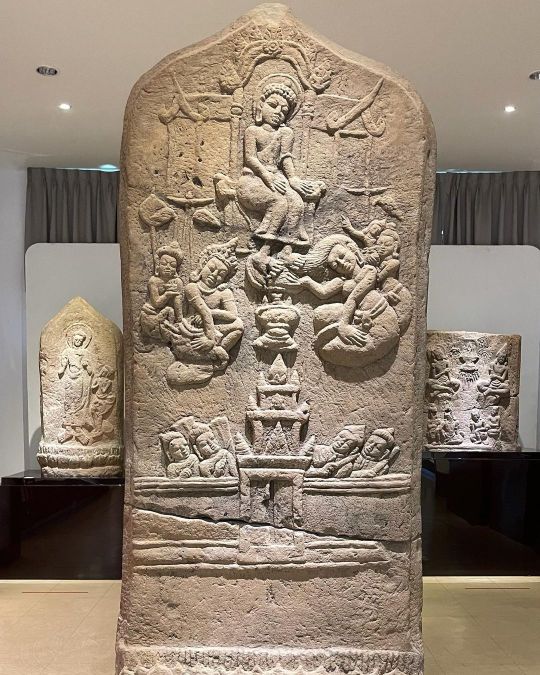#dvaravati
Explore tagged Tumblr posts
Text
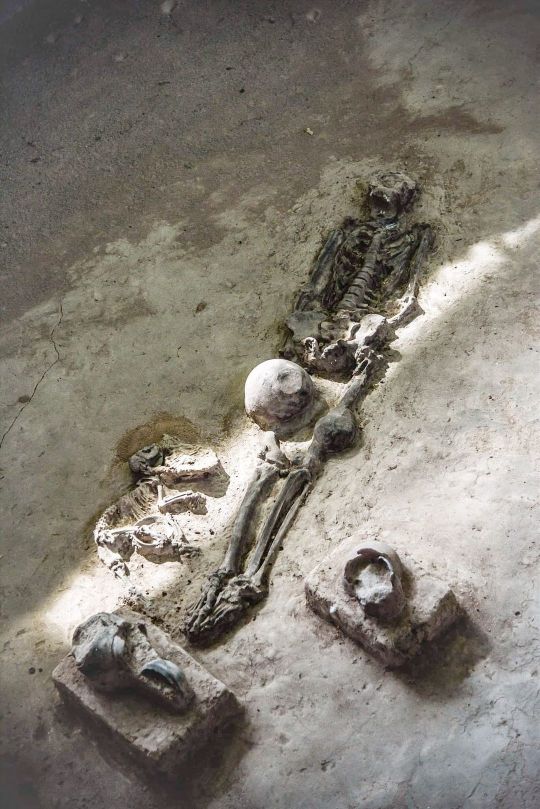
Ancient human female skeletons dated more than 2,000 years old from the "Dvaravati Empire, Si Thep city" (located in Thailand) were unearthed along with her personal possessions and a companion dog. "Dvaravati Empire" was the Mother of all civilisation (with influences from India) in mainland southeast Asia that thrived in Central Thailand from the 6th to the 10th centuries (pre-Angkor wat). "Si Thep" was officially added to UNESCO's world heritage list on September 19, 2023, more than one hundred years since it was discovered.
#ancient history#prehistoric#ancient civilization#archaeology#southeast asia#dvaravati empire#dvaravati#si thep#world heritage
62 notes
·
View notes
Text
youtube
Lecture: Dvāravatī Art and the Culture of Early Thailand – Between Tradition and Innovation, March 25, 2024
Daniel F. and Ada L. Rice Research Fellow Nicolas Revire discusses the material cultures of Thailand’s ancient Dvāravatī kingdom. Archeologists and historians are still uncovering Dvāravatī—an Indianized culture, kingdom, and art style that emerged in Southeast Asia. Though grounded in neighboring Indic artistic traditions, this 7th–8th century material culture also encompasses local innovations. In this talk, Revire maps what we know about Dvāravatī art and the history of early Thailand. The Art Institute of Chicago
#art institute of chicago#Thailand#Dvaravati kingdom#7th century#8th century#art#art history#Buddhism#Hinduism#archaeology#history#cultural amalgam#Mon people#Nicolas Revire
2 notes
·
View notes
Text
[Paper] Geo-Information Technology Application for Investigating the Old Lopburi River and the Ancient City of Dvaravati Period (6th-8th Century AD) Based on the Record of Queen Cāmadevi's Watercourse Travels in the Chao Phraya River Basin
LiDAR and geo-tech reveal Queen Cāmadevi's route and ancient Dvaravati cities, offering insights for heritage conservation and sustainable planning.
via Scientific Culture, 09 January 2024: A groundbreaking study utilizing geo-information technology, including LiDAR, has successfully traced the old Lopburi River and unearthed ancient Dvaravati cities along Queen Cāmadevi’s historical watercourse travels. The research identified 12 significant canals previously part of the river and pinpointed ancient urban centers, providing crucial insights…

View On WordPress
0 notes
Text
Snippet- SatraajitiVilaasa
Slash. Slash. Turn and slash as that happens. Slash. Slash. Move back like lightning before striking with a single step forward. Slash. Slash.
Satyabhama made up the new routine as She continued Her sword practice, something She ensured to do everyday, owing to Her love for making new routines, which She later taught Her elder brother, who then spoke to Dvarakesha and Balarama Dau about implementing them in the Narayani Sena.
Something told Her the Sena was named so due to the Shakti of Narayana being ever present there.
A smile danced on Her face as She continued Her practice, as the movement of Her routine increased in complication, every movement She made known to Her by automatic memory, something She had worked on since She was very young, even before Krishna had arrived at Mathura, in His Bliss, beauty, Light and Love, which was but a scratch on the surface of Krishna.
She paused Her movements, and inhaled before letting out a heavy breath, conserving Herself during practice. She was planning to make movements like what would occur during war, something that was imminent, considering the number of Kings who had a problem with Krishna, despite His ever cheerful, friendly way.
Why, just the other day, Mitravinda had sent Her a letter about tensions starting to mount in Vidarbha, especially in regards to the Princess of the Kingdom, Vaidarbhi Rukmini, considered one of the most beautiful women ever. Mitra had even told Her that Rukmini and Satyabhama resembled each other in looks, which was something Satyabhama Herself could understand immediately, owing to the nature the two of Them shared.
The tension in Vidarbha was preceded by the endless attacks of Jarasandha on the Yadavas, having caused the shift of the Kingdom from Mathura to Dvaraka, the land of Bliss and Moksha.
Dvaravati. Mokshasthali.
A step on the sand of Dvaraka will bring forth Moksha to one and to all, smiled Satyabhama, as She positioned Herself to continue Her routines.
She had other duties to tend to once She finished helping Her Yadava Sena.
********
@vibishalakshman @thelekhikawrites @thegleamingmoon @nspwriteups @whippersnappersbookworm @dr-scribbler @chiyaanvikram @nirmohi-premika @rang-lo @ambidextrousarcher For anyone who knows others who love Sanatana Dharma, please tag them, and let me know if you want/do not want to be tagged in this, I will not take offense.
27 notes
·
View notes
Text

ยูเนสโกประกาศ "ภูพระบาท" เป็นมรดกโลก
ยูเนสโกประกาศ "ภูพระบาท" เป็นมรดกโลก
ยูเนสโกประกาศขึ้นทะเบียน "อุทยานประวัติศาสตร์ภูพระบาท" จ.อุดรธานี เป็นมรดกโลกทางวัฒนธรรม ซึ่งถือเป็นแห่งที่ 5 ของไทย ต่อจากเมืองโบราณศรีเทพ จ.เพชรบูรณ์ ที่ประกาศไปเมื่อปีที่แล้ว ขณะที่กรมศิลป์เปิดให้เข้าชมอุทยานประวัติศาสตร์ภูพระบาท ฟรี 28 ก.ค.-12 ส.ค.นี้
วันนี้ (27 ก.ค.2567) องค์การเพื่อการศึกษาวิทยาศาสตร์ และวัฒนธรรมแห่งสหประชาชาติ หรือยูเนสโก ได้ประกาศให้อุทยานประวัติศาสตร์ภูพระบาท จังหวัดอุดรธานี เป็นมรดกโลกทางวัฒนธรรม ในชื่อ “ภูพระบาท ประจักษ์พยานแห่งวัฒนธรรมสีมา สมัยทวารวดี” (Phu Phrabat, a testimony to the Sīma stone tradition of the Dvaravati period)
ในการประชุมคณะกรรมการมรดกโลกสมัยสามัญ ครั้งที่ 46 ณ กรุงนิวเดลี สาธารณรัฐอินเดีย โดยเป็นแหล่งมรดกโลกลำดับที่ 8 และแหล่งมรดกโลกทางวัฒนธรรมแห่งที่ 5 ของประเทศไทย อีกทั้งยังเป็นแหล่งมรดกโลกแห่งที่ 2 ของ จ.อุดรธานี ต่อจากแหล่งโบราณคดีบ้านเชียง ที่ได้รับการขึ้นทะเบียนเป็นมรดกโลกจากยูเนสโก เมื่อ พ.ศ.2535
น.ส.สุดาวรรณ หวังศุภกิจโกศล รมว.วัฒนธรรม กล่าวว่า การที่อุทยานประวัติศาสตร์ภูพระบาท จ.อุดรธาน��� ได้รับการประกาศจากองค์การยูเนสโก ให้เป็นมรดกโลกทางวัฒนธรรมแห่งใหม่ ถือเป็นมรดกโลกทางวัฒนธรรมแห่งที่ 5 ของประเทศไทย ต่อจากนครประวัติศาสตร์พระนครศรีอยุธยา เมืองประวัติศาสตร์สุโขทัยและเมืองบริวาร แหล่งโบราณคดีบ้านเชียง จ.อุดรธานี และเมืองโบราณศรีเทพ จ.เพชรบูรณ์ ที่ได้รับการประกาศในปีที่ผ่านมา

โดยอุทยานประวัติศาสตร์ภูพระบาท ได้รับการประกาศให้เป็นมรดกโลก ภายใต้คุณค่าโดดเด่นอันเป็นสากล ได้แก่ การรักษาความเป็นของแท้และดั้งเดิมของแหล่งวัฒนธรรม สีมาหินสมัยทวารวดี และเป็นประจักษ์พยานที่ยอดเยี่ยมของการสืบทอดของวัฒนธรรมดังกล่าวที่ต่อเนื่องอย่างยาวนานกว่าสี่ศตวรรษ โดยเชื่อมโยงเข้ากับประเพณีของวัดฝ่ายอรัญวาสีในเวลาต่อมา
จึงขอเชิญชวนให้ชาวไทยทั่วประเทศร่วมแสดงความยินดี และเฉลิมฉลองในโอกาสที่ภูพระบาทได้รับการประกาศเป็นมรดกโลกแห่งใหม่ของไทย โดยกระทรวงวัฒนธรรม จะพยายามผลักดันให้เกิดแหล่งมรดกโลกแห่งใหม่ อย่างต่อเนื่อง
น.ส.สุดาวรรณ กล่าวอีกว่า กระทรวงวัฒนธรรม โดยกรมศิลปากร ได้ประกาศยกเว้นค่าธรรมเนียมเข้าชมอุทยานประวัติศาสตร์ภูพระบาท จ.อุดรธานี ระหว่างวันที่ 28 ก.ค.-12 ส.ค.2567 เพื่อให้ประชาชนคนไทยทุกคน ตลอดจนนักท่องเที่ยวต่างชาติได้ร่วมเฉลิมฉลองการประกาศขึ้นทะเบียน ภูพระบาทเป็นมรดกโลกในครั้งนี้

ภูพระบาท ได้รับการประกาศเป็นแหล่งมรดกวัฒนธรรมแบบต่อเนื่อง จำนวน 2 แหล่ง ประกอบด้วย
อุทยานประวัติศาสตร์ภูพระบาท และแหล่งวัฒนธรรมสีมา วัดพระพุทธบาทบัวบาน ตั้งอยู่ทางด้านทิศตะวันตกห่างจากอำเภอบ้านผือ จ.อุดรธานี ประมาณ 12 กิโลเมตร เป็นตัวแทนของวัฒนธรรมสีมาในสมัยทวารวดี (พุทธศตวรรษที่ 12-16) อันโดดเด่นที่สุดของโลก ตามเกณฑ์คุณค่าโดดเด่นอันเป็นสากล
ข้อที่ 3 คือสามารถอนุรักษ์ก ลุ่มใบเสมาหินสมัยทวารวดีที่มีจำนวนมาก และเป็นแหล่งใหญ่ที่สุดในโลก โดยใบเสมาดังกล่าว มีความสมบูรณ์และยังคงตั้งอยู่ในสถานที่ตั้งเดิม แสดงถึงวิวัฒนาการที่ชัดเจนของรูปแบบ และศิลปกรรมที่หลากหลายของใบเสมา ซึ่งทำหน้าที่เป็นเครื่องหมายกำหนดขอบเขตพื้นที่ศักดิ์สิทธิ์
และเกณฑ์ข้อที่ 5 ภูมิทัศน์ของภูพระบาทได้รับการปรับเปลี่ยนให้เหมาะสมกับการใช้พื้นที่เพื่อประกอบพิธีกรรมทางพุทธศาสนา และยังคงความสำคัญของกลุ่มใบเสมาหิน โดยความเชื่อมโยงเกี่ยวข้องกับประเพณีสงฆ์ในฝ่ายอรัญญวาสี (พระป่า)
ภูพระบาทจึงเป็นประจักษ์พยานที่โดดเด่นของการใช้ประโยชน์ของธรรมชาติ เป็นตัวแทนของวัฒนธรรมสีมา สมัยทวารวดี ซึ่งได้รับการสืบทอด รักษาวัฒนธรรมดังกล่าวที่ต่อเนื่องยาวนาน เชื่อมโยงประเพณีวัฒนธรรมของอรัญวาสีมาถึงปัจจุบัน
ด้าน นายนมัสวิน นาคศิริ นักโบราณคดีชำนาญการ อุทยานประวัติศาสตร์ภูพระบาท เปิดเผยว่า การเสนอขึ้นทะเบียนเป็นมรดกโลกมีอยู่ 2 ประเด็น คือ 1.อุทยานฯ ภูพระบาท ได้ปรากฏวัฒนธรรมเสมา ซึ่งเป็นคติความเชื่อที่ผสมผสาน ระหว่างการนับถือพื้นที่ศักดิ์สิทธิ์และการกำหนดขอบเขตพื้นที่ศักดิ์สิทธิ์ด้วยหลักหินหรือใบเสมา
ซึ่งประเด็นนี้อุทยานประวัติศาสตร์ภูพระบาทเป็นต้นแบบของการกำหนดพื้นที่อุโบสถที่มีใบเสมาล้อมรอบอย่างที่เห็นในปัจจุบัน
ประเด็นที่ 2 มีหลักฐานอันเด่นชัดว่า มีมนุษย์เข้ามาตั้งถิ่นฐานตั้งแต่สมัยก่อนประวัติศาสตร์เรื่อยมาจนถึงสมัยประวัติศาสตร์ โดยมนุษย์เหล่านี้ได้เข้ามาดัดแปลงหินให้เป็นสถานที่ประกอบพิธีกรรมทางพุทธศาสนา ดังปรากฏพระพุทธรูปภายในถ้ำหิน
สำหรับอุทยานประวัติศาสตร์ภูพระบาท เคยถูกเสนอเพื่อขึ้นทะเบียนเป็นมรดกโลกเมื่อปี 2547 ต่อมาถูกถอนรายชื่อกระทั่งปี 2559 ได้เสนอเพื่อให้มีการพิจารณาการขึ้นทะเบียนอีกครั้ง

เฮลั่น! "ภูพระบาท" เป็นมรดกโลกแห่งที่ 2 ของอุดรธานี
บรรยากาศในพื้นที่อุทยานประวัติศาสตร์ภูพระบาท ที่ อ.บ้านผือ จ.อุดรธานี วันนี้ คึกคักเป็นพิเศษ มีหัวหน้าส่วนราชการ ประชาชน และนักท่องเที่ยว มารอลุ้น การประกาศให้ภูพระบาทขึ้นทะเบียนเป็นมรดกโลก
โดยหอนางอุสา ซึ่งมีลักษณะเป็นโขดหินคล้ายรูปดอกเห็ดหรือหอคอยขนาดเล็ก ตั้งอยู่บนลานหินกว้าง ภายในอุทยานประวัติศาสตร์ภูพระบาท อ.บ้านผือ จ.อุดรธานี ซึ่งเป็นไฮไลท์ที่สำคัญสำหรับแหล่งโบราณคดี เพื่อประกอบการขึ้นทะเบียนเป็นมรดกโลกต่อยูเนสโก
ภายนอกหอนางอุสา ยังมีภาพเขียนสีทั้งส่วนฐานและส่วนบน เชื่อว่าเป็นการบันทึกเรื่องราวเกี่ยวกับความเชื่อของคนยุคก่อนประวัติศาสตร์ บริเวณบริเวณโดยรอบรองไปด้วยใบเสมาและถ้ำหินที่มีพระพุทธรูปสมัยทวารวดี ซึ่งบ่งบอกถึงความรุ่งเรืองของพระพุทธศาสนา โดยหอนางอุสาเชื่อว่าใช้ในการทำพิธีกรรมทางศาสนา จึงถือว่าเป็นสถานที่ศักดิ์สิทธิ์และชาวบ้านในละแวกนี้ให้ความเคารพศรัทธา

ไทยพีบีเอสได้พูดคุยกับนักท่องเที่ยว ซึ่งเดินทางมาจาก จ.เชียงใหม่ บอกว่า เป็นครั้งแรกที่มาท่องเที่ยวอุทยานประวัติศาสตร์ภูพระบาท และเพิ่งจะทราบข่าวว่าวันนี้คณะกรรมการจะมีการพิจารณาการขึ้นทะเบียนเป็นมรดกโลกลำดับที่ 6
ขณะที่นายนมัสวิน นาคศิริ นักโบราณคดีชำนาญการ อุทยานประวัติศาสตร์ภูพระบาท เปิดเผยว่า การเสนอขึ้นทะเบียนเป็นมรดกโลกมีอยู่ 2 ประเด็น คือ 1 อุทยานฯ ภูพระบาท ได้ปรากฏวัฒนธรรมเสมา ซึ่งเป็นคติความเชื่อที่ผสมผสานระหว่างการนับถือพื้นที่ศักดิ์สิทธิ์และการกำหนดขอบเขตพื้นที่ศักดิ์สิทธิ์ด้วยหลักหินหรือใบเสมา ซึ่งประเด็นนี้อุทยานประวัติศาสตร์ภูพระบาทเป็นต้นแบบของการกำหนดพื้นที่อุโบสถที่มีใบเสมาล้อมรอบอย่างที่เห็นในปัจจุบัน
และในประเด็นที่ 2 มีหลักฐานอันเด่นชัดว่ามีมนุษย์เข้ามาตั้งถิ่นฐานตั้งแต่สมัยก่อนประวัติศาสตร์เรื่อยมาจนถึงสมัยประวัติศาสตร์ โดยมนุษย์เหล่านี้ได้เข้ามาดัดแปลงหินให้เป็นสถานที่ประกอบพิธีกรรมทางพุทธศาสนา ดังปรากฏพระพุทธรูปภายในถ้ำหิน

Phu Phrabat Historical Park
CR :: https://www.thaipbs.or.th/news/content/342432
2 notes
·
View notes
Text
The Two Prime Consorts ❤︎
Rukmini and Satyabhama spare some time with each other in Dvaraka, post a work day.
When Suryanarayana's chariot rode below the horizon in the city of gates, the shades of saffron and dark mingling in one against the canvas of the welkin glimmered against the fair visage of the Narayani, the chief among the Ashtapatni of Keshava, who blessed the sun lord once before the lunar god arrived for his shift.
Rukmini's smile exuded the semblance of a fully bloomed water lily, bright pink and one dripping honey, much like her lotus eyes that crinkled in merry. Rolling back the dried scrolls, she interlocked her slender fingers against each other and gave a stretch, yawning with tears clinging to the corner of her eyes and a half-fatigued look eclipsing her usual Chanchala-ness.
Something swished against the shadows of Dvaravati castle's cloisters forged with finesse, quick to gain her attention. It played around on the whims of Vayu before a hand smothered it, deliberately camouflaging in the silence and semi-murk of the eventide. Krishnatmika frowned momentarily, eyebrows puckering before they rose again in glee. Grinning from ear to ear, she languidly shifted again in her seat, craning her neck to get a better look at whatever shenanigans Bhulakshmi was now upto.
"Ayi, I am not Bhanu to accompany his father in their monkey business. I am his mother, Rukku Jiji!" The unladly-like squeak that then addressed her, had Vaidarbhi doubling over as a pouting Satyabhama stepped out of the shadows; her hands on her hips with a look of betrayal and disbelief on her countenance.
"Very well, it's you after Kanha I see." She snorted, adding fuel to the mirth of her elder co-wife whose shoulders trembled by the laughter she tried subduing but to no avail.
"Aww, darling little Bhame, please have a seat. How may I assist you, my queen?" Rukmini pursed her lips, pushing back her amusement as Satyabhama rolled her eyes once more, shaking her head fondly; headstrong on maintaining the pseudo act of being offended but failed eventually. The latter moved around in unrushed steps, stationing more oil lamps in the corners of the council hall that contained no one but them for then, murmuring a hymn to the goddess of time.
"Samba was asking for his Jyeshtha Maa. Jamba Jiji told him she's got a more darling child," Satyabhama giggled while spinning on her heels, as a horrified Rukmini felt bad for snickering again. "He's been ceaselessly wailing like a typical child since, and needless to say, Yamuna's enjoying it. She even teased him for his other favourite Maa's too busy with Satyaa's little one." She mimicked the lisp of the Krishnaputra in the end, an exasperating amusement in her demeanour as Rukmini for the perhaps the first time in her life, was at a loss of words.
"Leave you, it's Kalindi who has unofficially vowed to not let me live in peace for once."
"No no, that designation is mine. I'll fight Yama to have his twin in place you see."
A short snug silence filled their space, an ecstasy in their hearts as was their nature. Satyabhama returned to Rukmini with a dramatic look of conflict in her eyes and a bowl of heated oil in her hand.
Bhudevi seated herself on a couch placed at a corner, before enthroning Rukmini's head on her lap, letting the latter's tresses loose to sprawl around like tendrils of forest vegetation, jasmine flowers caged in them at irregular intervals. The vermillion smeared forehead of the princess of Shrikshetra gave the image of the sun itself, eyes like stars curtained with a thin stretch of coral tinctured flesh. She was as precious to Madhava as the moon was to the poets, her bracing aura eternally enrapturing the patron of sustenance.
Prathama Dvarakeshvari studied the half-glare thrown her way before blinking, hauling her soul sister from the reverie of admiration she retained for her, "What are you looking at, Bhame?"
"On a scale of 1 to 10, how much do I love you for not pulling your ears for being late, big sister?" Varahi shook her head from side to side, experiencing irk and affection at once.
Krishnatmika flushed sheepishly before cheekily smiling as a pair of fingers slid in her scalp, the empyrean aroma of camphor infused almond oil wafting in the air around and having her almost melt like butter, "10 on 10, Vasundhare. You'll punish me, your beloved Shri? Will you not think of my darling ears?"
Satyabhama continued with her work, her doting eyes softening further as she felt Rukmini gradually flop, exhaling a sigh of relief and burying her face in the former's lap, "I shall have you locked away from the council for a week, do not forget that Mata Kokila's ferral cat is here to endorse and assist my shenanigans too."
'This scion of the flames is beholden to your majesty for thy exquisite choice of words recounting my magnificence, Shri Shri Dvaraka Maharani. It's a shame I am not as competent as you in terms of analogies and vocabulary. Grant this servant with leniency, good lady.’ A mordant smile flashed from the other end of the mind bond as Satyabhama bowed in her sitting position, putting a hand on her chest in comic gratitude.
'You're welcome and pardoned, peasant.'
Rukmini smiled again, thoroughly relishing the repartee as the other Bharyas too joined in from different parts of the castle itself, each with more audacious, either too advanced or lame humoured responses to the other's teasing.
What would she do without these brats?
#ashtabharya#rukmini#satyabhama#krishna#kanha#dwarka#bhudevi#shridevi#dhruvi writes 📜࿐ ࿔*:・゚#Hehe- A very raw piece of writing here. Also if anyone's wondering#I have an OC in here. Don't mind her tho lmao.#Feel free to point out the mistakes!
23 notes
·
View notes
Text

🗺 Always top-listed among history buffs anywhere, Sukhothai Historical Park is the seat of the ancient Dvaravati Dynasty. Its still-present remnants are considered so significant that the area has become a UNESCO World Heritage Site.
#AmazingThailand
5 notes
·
View notes
Note
Hi! saw that you were not feeling well so I didn't want to bother you much. But now that you're back, can I ask you about the mountain fortress in Songbird? I looked at the monastery that you referenced but as a person who's from a place that doesn't have mountains much less mountain fortresses, it's hard to wrap my mind around the idea of it. But I love the idea that a city can just exist like you described so I wanted to ask if you have more reference pictures or places I can look up? The pictures I found on Pinterest aren't much helpful lol
Hmm 🤔 this is a tough one. I have travelled in the mountains a lot so the concept came easily to me without consulting any specific reference picture but there are certain photos that I kept around to consult for descriptions. I'm including those in hopes that it gives you a clearer picture.
First, this cover art I found on pinterest, of this book called The King of Ashes. But this is more of a coastal city in the western world than a mountain fortress in Asia.
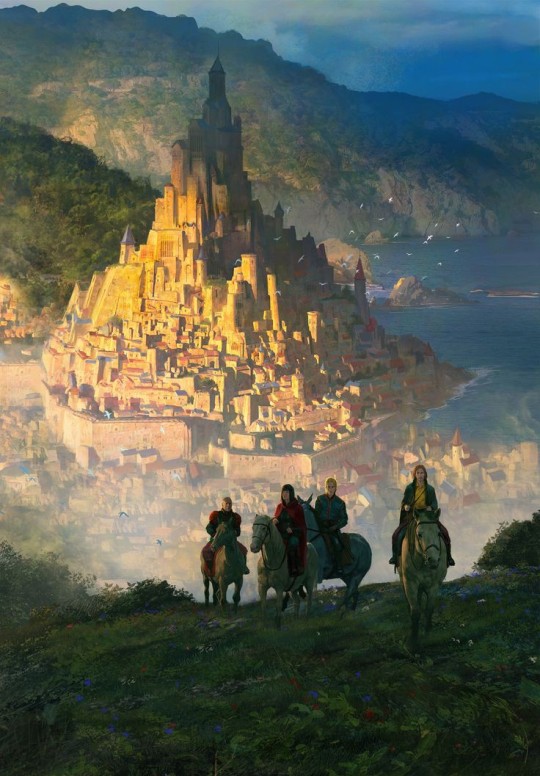
Second, these pics I clicked of the Key monastery of Himachal Pradesh, India. It is said to be around a 1000 years old so not too far from the Dvaravati period, though set in widely different cultures. This is how I imagined the buildings were stacked but obviously with way more trees because vegetation type is completely different.
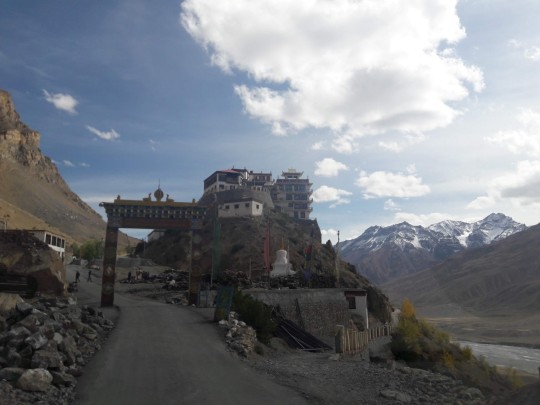
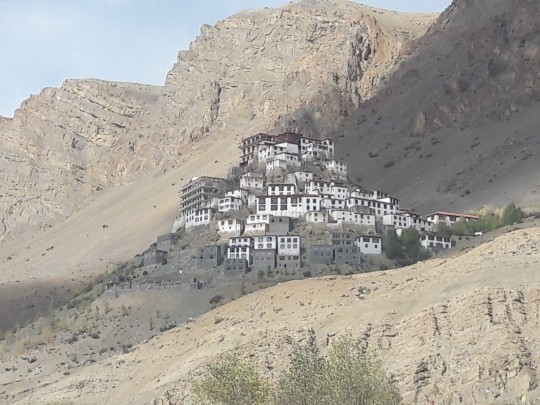
Third, I have this quick sketch I made to help me conceptualize the city. There isn't a lot of description about the city in the 1st chapter but we will see more of it as we move further into the story.
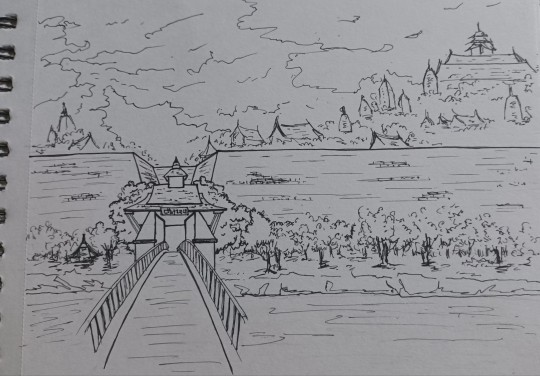
How the two rivers meet—
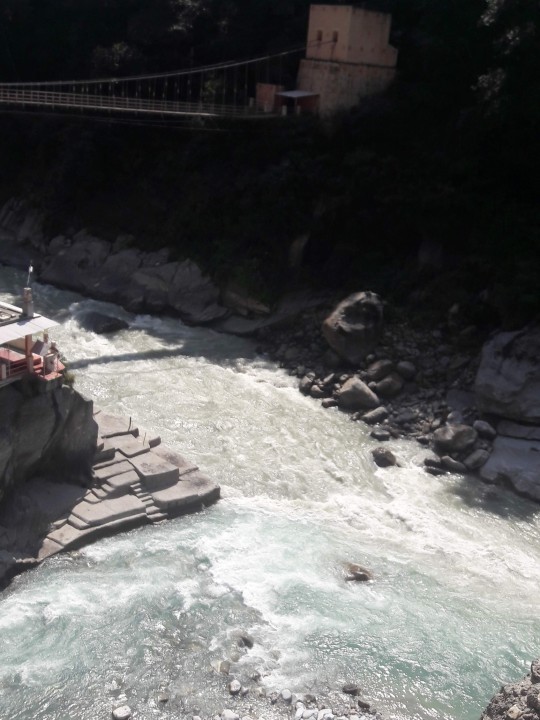
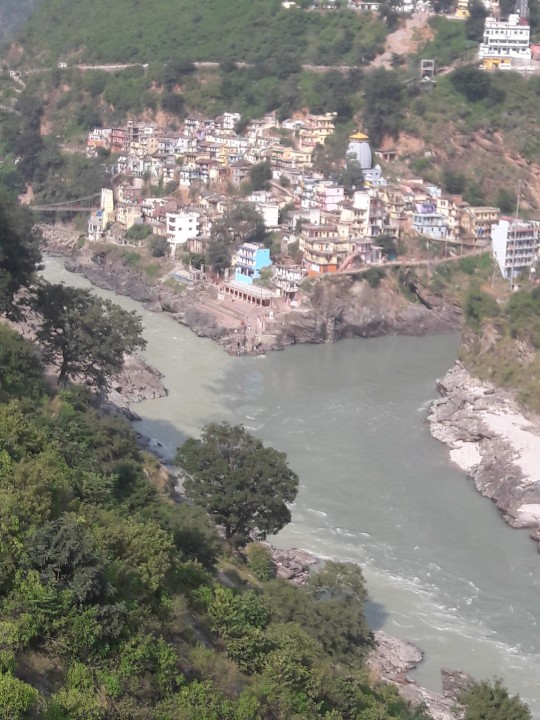
As you can see from the two different colours of water, this is the confluence of two different rivers. This is Uttarakhand, India. (Interesting tidbit - You are looking at the creation of the river Ganga here.) Both pics are also by me.
The following two pictures are how I imagined tbe river to look like. They are also from Uttarakhand and were clicked by me.

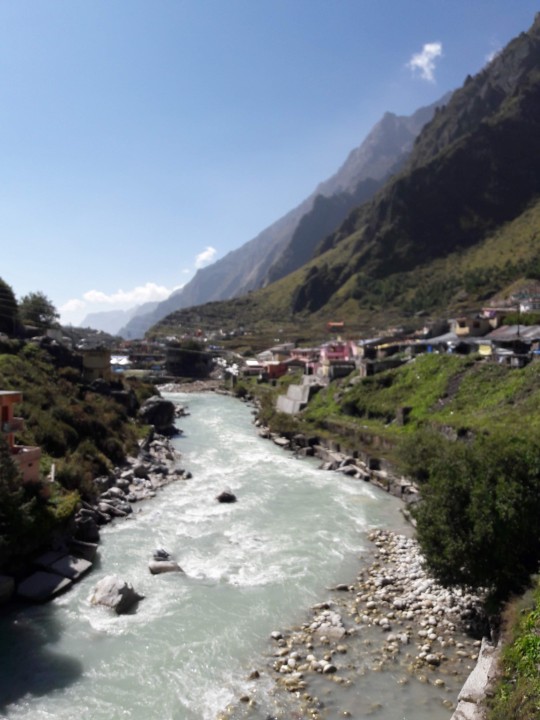
Lastly, this is how I imagine the scenary that Porsche travels through —
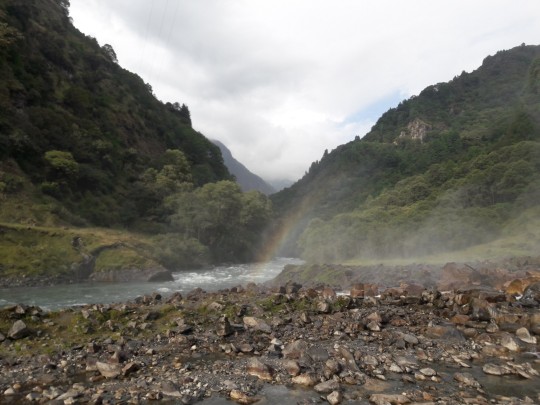
This is Arunachal Pradesh, India and like the others, I clicked this one as well.
Apart from all this, Punakha Monastery was a large influence but most of that came from memory instead of any particular picture.
Hope this helped you!
2 notes
·
View notes
Text

item # K24A48
VERY RARE Pra Pang Pert Lohk Meu Ting Ding, Nagak Ngern, Lang Ut Pong Wan, A-najak Dvaravati. An ancient embossed silver sheet with a bas-relief of a standing Buddha in standing position with feet together, arms and hands beside the body (Pra Pang Pert Lohk Meu Ting Ding in Thai). In the back is with a trace of paste of auspicious plants powder and fragments. In the history of the live of Buddha, this gesture represents Buddha made the realms of existence (heaven, earth and hell) visible. A term in Buddhism that typically refers to the three realms of existence: desire, form, and formless. Refers to the realms of existence that beings should not cling to, emphasizing the need for renunciation, and the realms that beings experience life, suffering, and enlightenment. This amulet was made over 1000 years ago, and was discovered at the ruin of Phrarot City, Kingdom of Dvaravati, Phanasnikhom district, Chonburi Province.
……………………………………………………..
BEST FOR: Thais believe that regardless of the problems you face in life, Pra Pang Pert Lohk will guide you towards the best possible solution, leading you to a path of overcoming challenges and experiencing positive outcomes, essentially finding a "glorious way" out of any difficulty. Pra Pang Pert Lohk will remove all the obstacles in your life, and bring glorious future, not only to you yourself, but also your family members. Pra Pang Pert Lohk will flip your bad luck, and misfortune to the best one possible with his hands. This amulet has a tendency to draw positive energy. Klawklad Plodpai (it pushes you away from all danger), Kongkraphan (it makes you invulnerable to all weapon attack), Maha-ut (it helps stop gun from shooting at you), and warning of danger. Nang Nieow, a rock-hard skin that is completely impervious to damage with bludgeoning or piercing weapons. Wealth Fetching, Maha Larp (it brings lucky wealth), Metta Maha Niyom (it makes people around you love you, be nice to you, and willing to support you for anything), Kaa Kaai Dee (it helps tempt your customers to buy whatever you are selling, and it helps attract new customers and then keep them coming back, Ponggan Poot-pee pee-saat Kunsai Mondam Sa-niat jan-rai Sat Meepit (it helps ward off evil spirit, demon, bad ghost, bad omen, bad spell, curse, accursedness, black magic, misfortune, doom, and poisonous animals). And this amulet helps protect you from manipulators, backstabbers,and toxic people.
……………………………………………………..
Dvaravati
Dvaravati was an ancient Mon political principality from the 6th century to the 11th century that was located in the region now known as central Thailand. It was described by Chinese pilgrims in the middle of the 7th century as a Buddhist kingdom named To-lo-po-ti situated to the west of Isanapura (Cambodia) and to the east of Sri Ksetra (Burma). Dvaravati also refers to a culture, an art style, and a disparate conglomeration of principalities of Mon people. Archaeological research over the past two decades or so has revealed the presence of a "Proto-Dvaravati" period which spans the 4th to 5th centuries, and perhaps earlier.
Dvaravati lost its importance after the rise of the Angkor in the lower Mekong basin around the 11th–13th centuries. In the 14th century, one of its main principalities, Si Thep, was almost left abandoned, while the remaining was split into the city-state confederation of Suphannabhumi in the west and the Lavo Kingdom in the east. However, a new kingdom, Ayutthaya, was subsequently founded southward on the bank of the Chao Phraya River in 1351, as the succeeded state, as its capital's full name referred to the Kingdom of Dvaravati; Krung Thep Dvaravati Si Ayutthaya (Thai: กรุงเทพทวารวดีศรีอยุธยา). All former Dvaravati principalities, Lavo, the northern cities of the Sukhothai Kingdom, and Suphannabhumi, was later incorporated to the Ayutthaya Kingdom in 1388, 1438, and the mid-15 century, respectively.
According to an inscription on a bronze gun acquired by the Burmese in 1767, when Ayuthia, Siam's capital at the time, fell to an invading Burmese force, the Burmese still referred to Ayutthaya as Dvaravati. Several genetic studies published in the 2020s also founded the relations between the Mon people and Siamese people (Central Thai people) who were the descendants of the Ayutthaya.
……………………………………………………..
Phrarot City
In Dvaravati period and Lop Buri period, approximately 1400-700 years ago, Chonburi Province displayed in the history since Dvaravati period. There are traces of the city known as "Muang Phrarot" , today Na Phrathat district and Phanasnikhom district, Chonburi Province. Phrarot city located at the lowland where has many rivers to converge and becoming Phanthong river. The Phrarot city’s inhabitants could use the river to transport, to contact with Sri Mahosot City in Prachinburi (In present this area is Ban Sra Ma Khua, Ban Khok Wat and Ban Nho Sa Kae) until Aranyapratate Tai. Moreover, It also had a pedestrian path connecting to Rayong Province and Chanthaburi Province. The route pass Paya Rae, the other ancient city of Chonburi. Phrarot City became a transportation hub of Chonburi in that time. Archaeologists had found that Phrarot City was an ancient city in the same period with Sriphalo City because it appeared an ancient pathway connecting the two cities at a distance of approximately 20 kilometers.
……………………………………………………..
DIMENSION: 5.40 cm high / 2.10 cm wide / 1.00 cm thick
……………………………………………………..
item # K24A48
Price: price upon request, pls PM and/or email us [email protected]
100% GENUINE WITH 365 DAYS FULL REFUND WARRANTY
Item location: Hong Kong, SAR
Ships to: Worldwide
Delivery: Estimated 7 days handling time after receipt of cleared payment. Please allow additional time if international delivery is subject to customs processing.
Shipping: FREE Thailandpost International registered mail. International items may be subject to customs processing and additional charges.
Payments: PayPal / Western Union / MoneyGram /maybank2u.com / DBS iBanking / Wechat Pay / Alipay / INSTAREM / PromptPay International / Remitly
*************************************************
0 notes
Text
"Sejarah Thailand: Dari Kerajaan Kuno hingga Era Modern yang Dinamis"

Thailand, yang dikenal sebagai "Negara Seribu Pagoda," memiliki sejarah yang kaya dan beragam. Terletak di jantung Asia Tenggara, Thailand telah mengalami berbagai periode dan perubahan, mulai dari kerajaan kuno hingga modernitas yang dinamis.
Kerajaan Kuno dan Awal Mula
Sejarah Thailand dimulai dengan kerajaan-kerajaan kuno seperti Funan dan Dvaravati yang muncul sekitar abad ke-1 hingga ke-11 M. Kerajaan Khmer, yang berpusat di Kamboja, juga memengaruhi wilayah ini, terutama dalam hal budaya dan agama. Namun, kerajaan yang paling dikenal adalah Sukhothai, yang berdiri pada abad ke-13. Raja Ramkhamhaeng dianggap sebagai pendiri, yang juga memperkenalkan tulisan Thai.
Kerajaan Ayutthaya
Setelah Sukhothai, Kerajaan Ayutthaya didirikan pada tahun 1350 dan menjadi salah satu pusat perdagangan dan budaya yang penting di Asia Tenggara. Ayutthaya dikenal karena arsitektur megah dan sistem pemerintahannya yang maju. Namun, pada tahun 1767, kerajaan ini hancur akibat serangan tentara Burma, menandai akhir dari periode tersebut.
Kerajaan Thonburi dan Awal Dinasti Chakri
Setelah kejatuhan Ayutthaya, Raja Taksin mendirikan Kerajaan Thonburi, yang berlangsung singkat. Pada tahun 1782, Raja Rama I mendirikan Dinasti Chakri dan memindahkan ibu kota ke Bangkok, yang tetap menjadi ibu kota Thailand hingga sekarang. Dinasti Chakri memainkan peran penting dalam modernisasi Thailand, termasuk reformasi administrasi dan militer.
Perubahan dan Modernisasi
Pada akhir abad ke-19, Raja Chulalongkorn (Rama V) memperkenalkan berbagai reformasi yang mendukung modernisasi, seperti pendidikan dan sistem transportasi. Thailand juga berhasil mempertahankan kemerdekaannya di tengah kolonialisasi Eropa, dengan menghindari penjajahan langsung melalui diplomasi yang cermat.
Era Abad ke-20 dan Perang Dunia II
Thailand terlibat dalam Perang Dunia I sebagai sekutu, namun di bawah tekanan Jepang, Thailand mengadopsi kebijakan pro-Jepang selama Perang Dunia II. Setelah perang, Thailand kembali ke jalur demokrasi, meskipun sering mengalami perubahan pemerintahan melalui kudeta militer.
Politik Modern dan Krisis
Sejak akhir abad ke-20, Thailand mengalami berbagai krisis politik dan sosial, termasuk protes besar-besaran yang sering kali berujung pada kudeta. Ketegangan antara kelompok pendukung dan penentang mantan Perdana Menteri Thaksin Shinawatra menjadi salah satu isu utama politik Thailand. Pada tahun 2014, militer melakukan kudeta dan mengambil alih pemerintahan.
Kesimpulan
Sejarah Thailand adalah perjalanan panjang yang mencerminkan kekayaan budaya, ketahanan, dan dinamika politik. Dengan warisan yang kaya dan identitas yang kuat, Thailand terus beradaptasi dengan tantangan modern sambil mempertahankan tradisi dan budayanya. Memahami sejarahnya sangat penting untuk menghargai posisi Thailand di kancah internasional saat ini.
0 notes
Text

2023 : La ville ancienne de Si Thep et ses monuments de Dvaravati associés. Thaïlande
Il s’agit d’un bien en série composé de trois éléments constitutifs : un site caractéristique de villes jumelles, qui comprend une ville intérieure et une ville extérieure entourées de douves ; le monument ancien massif de Khao Klang Nok ; et le monument ancien de la grotte de Khao Thamorrat. Ensemble, ces sites représentent l’architecture, les traditions artistiques et la diversité religieuse de l’empire de Dvaravati qui s’épanouit du VIe au Xe siècle, témoignant des influences de l’Inde. L’adaptation locale de ces traditions fut à l’origine d’une nouvelle tradition artistique dénommée l’école d’art de Si Thep, qui influença par la suite d’autres civilisations d’Asie du Sud-Est.
0 notes
Text

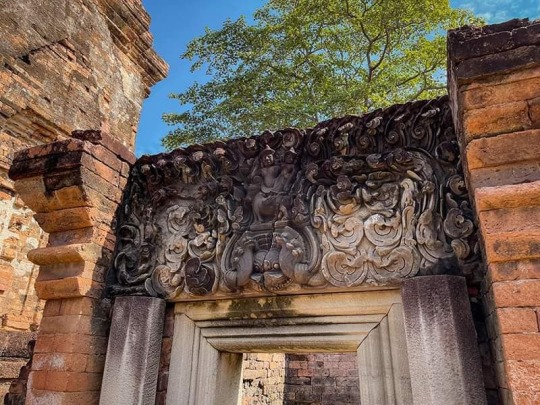

Introducing the "Dvaravati Empire", the Mother of all civilisation (with influences from India) in mainland southeast Asia that thrived in Central Thailand from the 6th to the 10th centuries (pre-Angkor Wat). At its peak, the town was a thriving cultural and trading metropolis that celebrated Hindu and Buddhist beliefs. "Si Thep" was officially added to UNESCO's world heritage list on September 19, 2023, more than one hundred years since it was discovered.
45 notes
·
View notes
Photo

Model dressed in Dvaravati period clothes, Thailand
31 notes
·
View notes
Text
Sacred Summit: Khao Thamorrat's Ancient Worship Unveiled
Discover Khao Thamorrat: A sacred mountain near Sri Thep, home to ancient Buddhist sculptures and a testament to enduring faith.
via Thai PBS, 30 January 2024: Khao Thamorrat, a mountain near Si Thep in Phetchabun province, Thailand, holds a significant place in history as a sacred site and natural landmark. The mountain, accessible by a steep trail, features a cave with ancient Buddhist sculptures and active stalagmites and stalactites. Despite the challenges of the climb, locals and visitors continue to make the…

View On WordPress
0 notes
Photo


Present-day flags of Monland
(Originally posted on DeviantArt: 14th June, 2016 and 11th December, 2019)
#mon#mons#monland#thai#thailand#flag#flags#dvaravati#bangkok#ayutthaya#austroasiatic#indochina#vexillology#alternate history
1 note
·
View note
